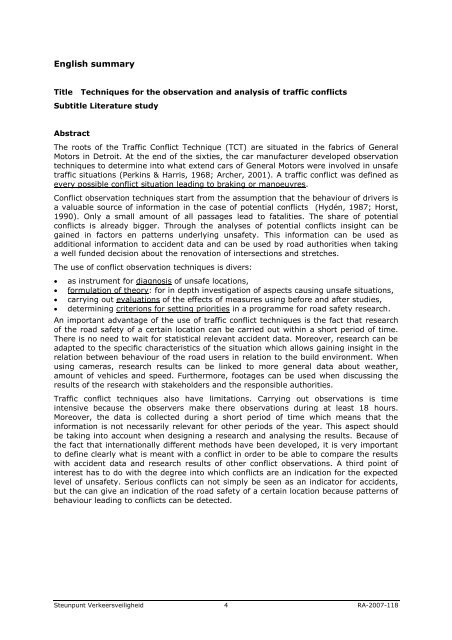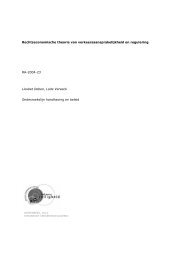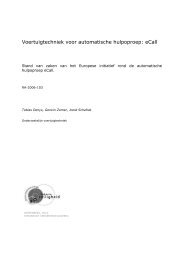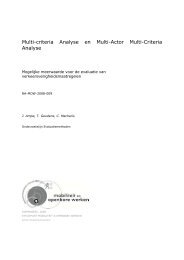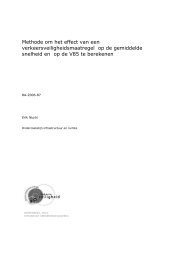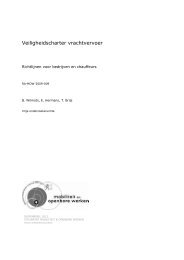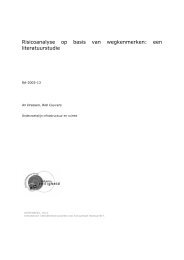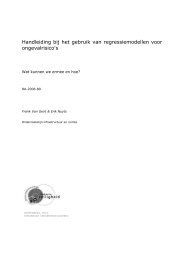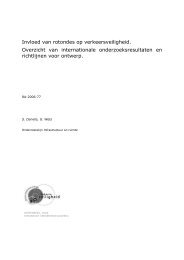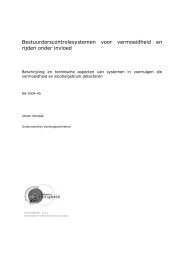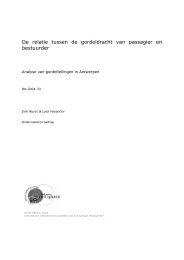Technieken voor de observatie en analyse van verkeersconflicten
Technieken voor de observatie en analyse van verkeersconflicten
Technieken voor de observatie en analyse van verkeersconflicten
Create successful ePaper yourself
Turn your PDF publications into a flip-book with our unique Google optimized e-Paper software.
English summary<br />
Title Techniques for the observation and analysis of traffic conflicts<br />
Subtitle Literature study<br />
Abstract<br />
The roots of the Traffic Conflict Technique (TCT) are situated in the fabrics of G<strong>en</strong>eral<br />
Motors in Detroit. At the <strong>en</strong>d of the sixties, the car manufacturer <strong>de</strong>veloped observation<br />
techniques to <strong>de</strong>termine into what ext<strong>en</strong>d cars of G<strong>en</strong>eral Motors were involved in unsafe<br />
traffic situations (Perkins & Harris, 1968; Archer, 2001). A traffic conflict was <strong>de</strong>fined as<br />
every possible conflict situation leading to braking or manoeuvres.<br />
Conflict observation techniques start from the assumption that the behaviour of drivers is<br />
a valuable source of information in the case of pot<strong>en</strong>tial conflicts (Hydén, 1987; Horst,<br />
1990). Only a small amount of all passages lead to fatalities. The share of pot<strong>en</strong>tial<br />
conflicts is already bigger. Through the <strong>analyse</strong>s of pot<strong>en</strong>tial conflicts insight can be<br />
gained in factors <strong>en</strong> patterns un<strong>de</strong>rlying unsafety. This information can be used as<br />
additional information to acci<strong>de</strong>nt data and can be used by road authorities wh<strong>en</strong> taking<br />
a well fun<strong>de</strong>d <strong>de</strong>cision about the r<strong>en</strong>ovation of intersections and stretches.<br />
The use of conflict observation techniques is divers:<br />
<br />
<br />
<br />
<br />
as instrum<strong>en</strong>t for diagnosis of unsafe locations,<br />
formulation of theory: for in <strong>de</strong>pth investigation of aspects causing unsafe situations,<br />
carrying out evaluations of the effects of measures using before and after studies,<br />
<strong>de</strong>termining criterions for setting priorities in a programme for road safety research.<br />
An important ad<strong>van</strong>tage of the use of traffic conflict techniques is the fact that research<br />
of the road safety of a certain location can be carried out within a short period of time.<br />
There is no need to wait for statistical rele<strong>van</strong>t acci<strong>de</strong>nt data. Moreover, research can be<br />
adapted to the specific characteristics of the situation which allows gaining insight in the<br />
relation betwe<strong>en</strong> behaviour of the road users in relation to the build <strong>en</strong>vironm<strong>en</strong>t. Wh<strong>en</strong><br />
using cameras, research results can be linked to more g<strong>en</strong>eral data about weather,<br />
amount of vehicles and speed. Furthermore, footages can be used wh<strong>en</strong> discussing the<br />
results of the research with stakehol<strong>de</strong>rs and the responsible authorities.<br />
Traffic conflict techniques also have limitations. Carrying out observations is time<br />
int<strong>en</strong>sive because the observers make there observations during at least 18 hours.<br />
Moreover, the data is collected during a short period of time which means that the<br />
information is not necessarily rele<strong>van</strong>t for other periods of the year. This aspect should<br />
be taking into account wh<strong>en</strong> <strong>de</strong>signing a research and analysing the results. Because of<br />
the fact that internationally differ<strong>en</strong>t methods have be<strong>en</strong> <strong>de</strong>veloped, it is very important<br />
to <strong>de</strong>fine clearly what is meant with a conflict in or<strong>de</strong>r to be able to compare the results<br />
with acci<strong>de</strong>nt data and research results of other conflict observations. A third point of<br />
interest has to do with the <strong>de</strong>gree into which conflicts are an indication for the expected<br />
level of unsafety. Serious conflicts can not simply be se<strong>en</strong> as an indicator for acci<strong>de</strong>nts,<br />
but the can give an indication of the road safety of a certain location because patterns of<br />
behaviour leading to conflicts can be <strong>de</strong>tected.<br />
Steunpunt Verkeersveiligheid 4 RA-2007-118


